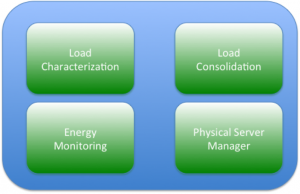The primary focus of the Energy Theme is on reducing the energy consumption of cloud computing resources. As compute nodes consume most of the energy in cloud computing systems, work to date has been focused on reducing the energy consumed by compute loads, particularly within the Openstack context. Although, as servers get increasingly instrumented, it is clear that there is potential in understanding the energy consumption with finer granularity and ultimately this can lead to energy efficiencies and cost savings.
Architecture
In the current work, the primary mechanism to achieve energy efficiencies is load consolidation combined with power control of servers. This could be augmented with managing server CPU power states, but it remains to be seen if this will lead to significant power savings. Another tool to achieve energy efficiencies is to add elastic load when the resources are underutilized – this does not reduce the overall energy consumption per se, but rather enables providers to get more bang for their energy buck.
The current architecture of the Cloud Energy Efficiency Subsystem is shown above with the components performing the following functions:
- an energy monitoring component: this obtains information on the energy consumption of the entire system – it may also make some kind of abstraction rather than working with highly granular data for each node;
- a load characterization component: this component uses primarily ceilometer data to understand what is going on in the cloud – it makes an abstraction of the usage of the system over different timescales and particularly determines which level of burstiness exists in the load patterns;
- a load consolidation mechanism: this will take the info on the system state and identify where load consolidation can be performed – it then issues a set of live migration instructions to the cloud to perform the consolidate. In general, it would be necessary to add some filters to support different hypervisors, bare metal servers, etc which makes it more complex;
- physical server manager: this will turn off servers and turn them on as necessary – this will take input from the load characterization component to determine how much spare capacity to keep in the system to deal with variations in demand.
The specific interactions between these components is evolving as this is a work in progress.
Initiatives
At present, the theme comprises of two initiatives. These are
